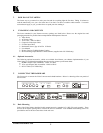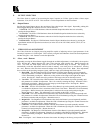
Kramer Electronics Ltd.
3
1 INTRODUCTION
Congratulations on your purchase of this Kramer Electronics Video Scaler. Since 1981, Kramer has been
dedicated to the development and manufacture of high quality video/audio equipment. The Kramer line has
become an integral part of many of the best production and presentation facilities around the world. In recent
years, Kramer has redesigned and upgraded most of the line, making the best even better. Kramer’s line of
professional video/audio electronics is one of the most versatile and complete available, and is a true leader in
terms of quality, workmanship, price/performance ratio and innovation. In addition to the Kramer line of high
quality Video Scalers, such as the one you have just purchased, Kramer also offers a full line of high quality
Video Scalers, matrix switchers, distribution amplifiers, processors, interfaces, controllers and computer-related
products. This manual includes configuration, operation and option information of the following Kramer Video
Scalers for the video professional. These Video Scalers are similar in operation but differ in features.
VP-721DS VP-722DS
1.1 A Word about Video Scalers
Kramer’s Digital Video Scalers are designed to convert Composite and S-Video signals to a variety of computer
resolutions. Different versions are required to handle NTSC and PAL video standards. Kramer Video Scalers
have many features to enhance performance. AFM (Adaptive Film Mode) is an automatic 3:2 pull-down
detector that provides clear and crisp de-interlacing video from 24 frames-per-second film. It offers significant
enhancements when viewing movies on a large screen. VT (Vertical Temporal Filter) can remove jagged edges
and other de-interlacing artifacts for video motion sequences. Our Static Picture Detector uses a simple field
merging technique to perform de-interlacing and it is very beneficial for static images or scenes with very little
or no motion.
1.2 Factors Affecting Quality of Results
There are many factors affecting the quality of results when Composite or S-Video signals are de-interlaced and
up-converted (scaled) to computer resolutions. Some basic precautions will ensure the best possible
performance from your Video Scaler.
Output display device
– The quality of the output signal will depend largely upon the type and quality
of display device used. Specifically, some video projectors just look better than others.
Distance between the Video Scaler and the display device – This plays a major role in the final result.
Long distances are possible, but special measures should be taken in order to avoid cable losses. These
include using high quality (coax-type) cables or adding line amplifiers.
Output connection cables – Low quality cables are susceptible to interference. They degrade signal
quality due to poor matching and cause elevated noise levels. Therefore, cables should be of the best
quality. Coax-type computer cables are because of their superior internal shielding characteristics.
Interference from neighboring electrical appliances – These can have an adverse effect on signal
quality. For example, an older computer monitor often emits very high electromagnetic fields that can
interfere with the performance of video equipment in its proximity.
















